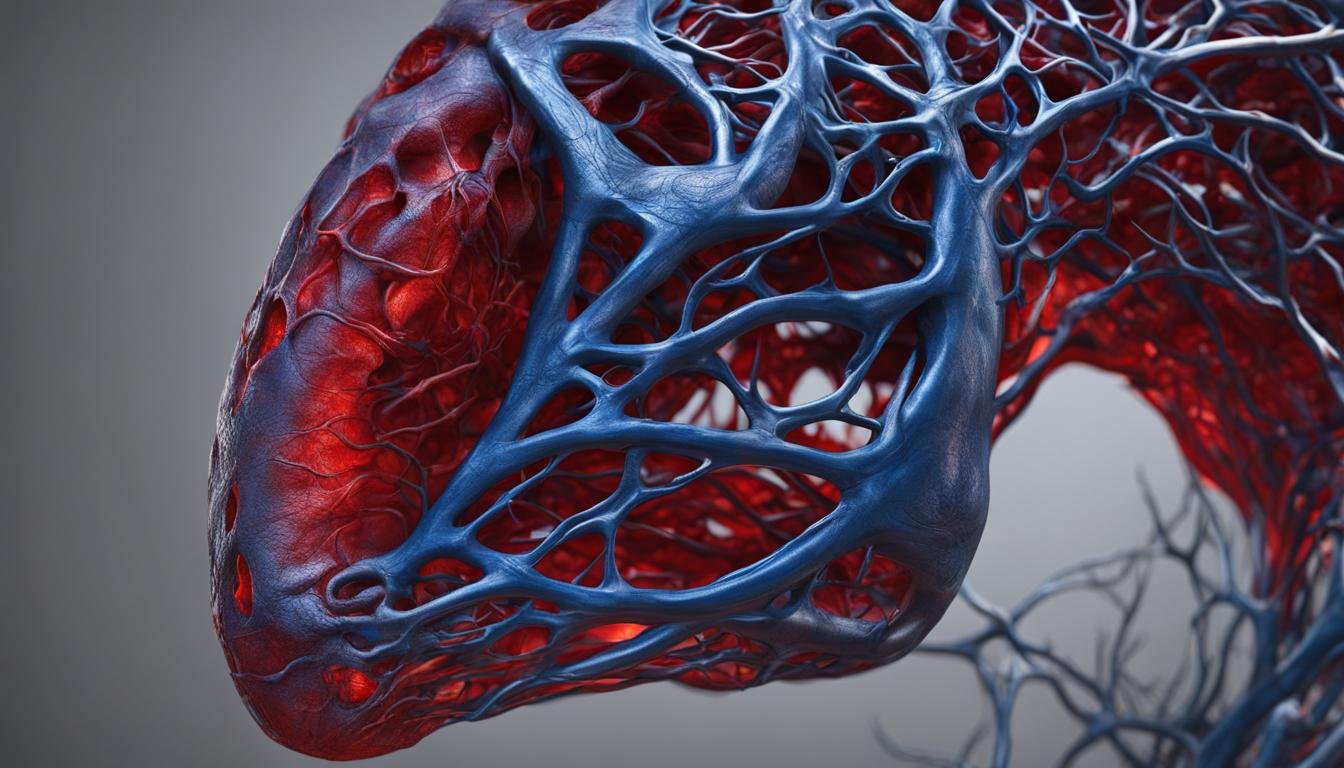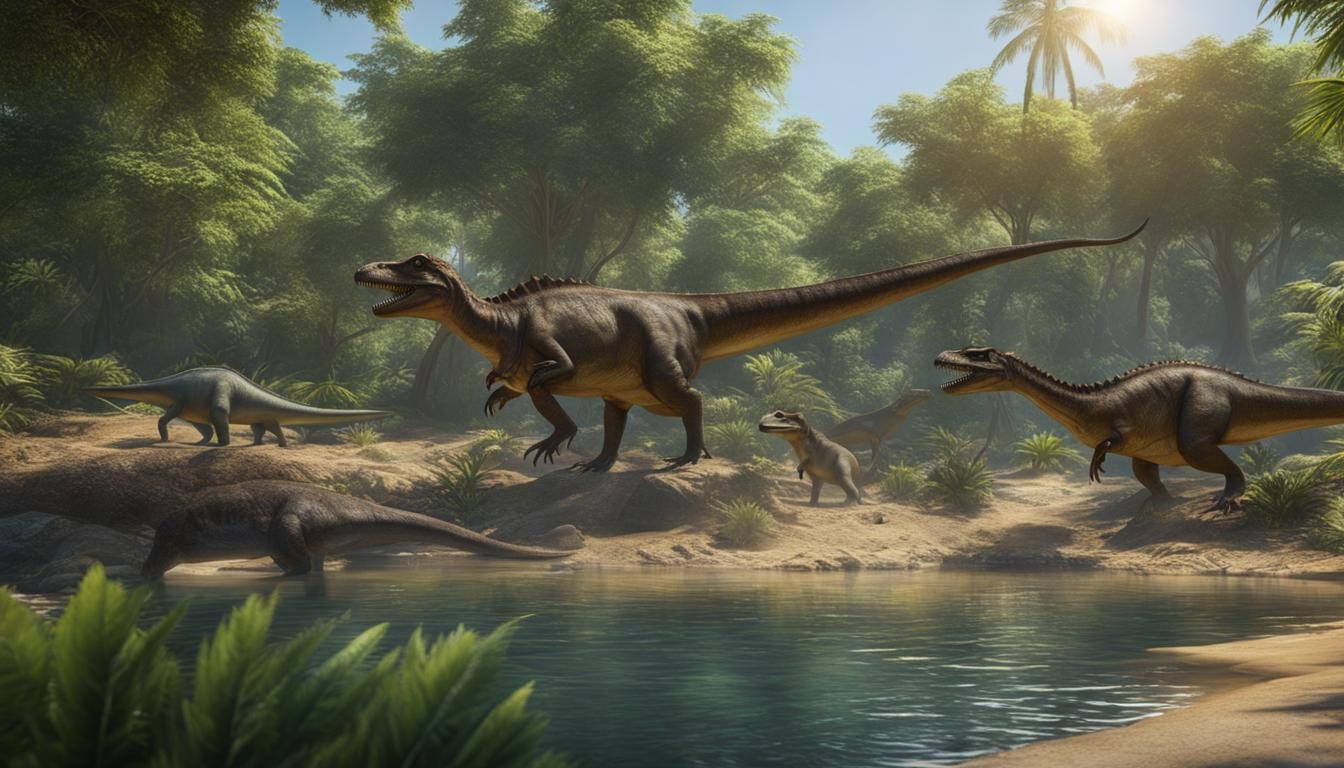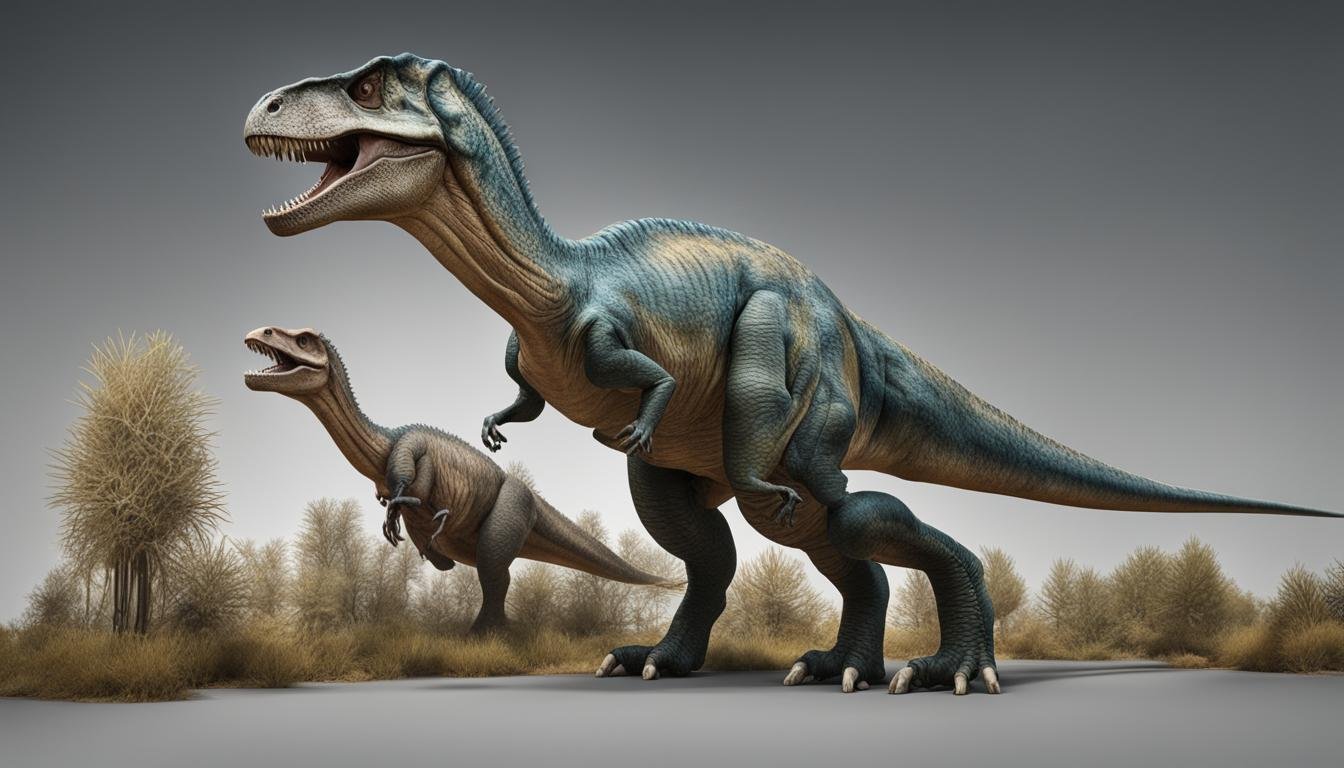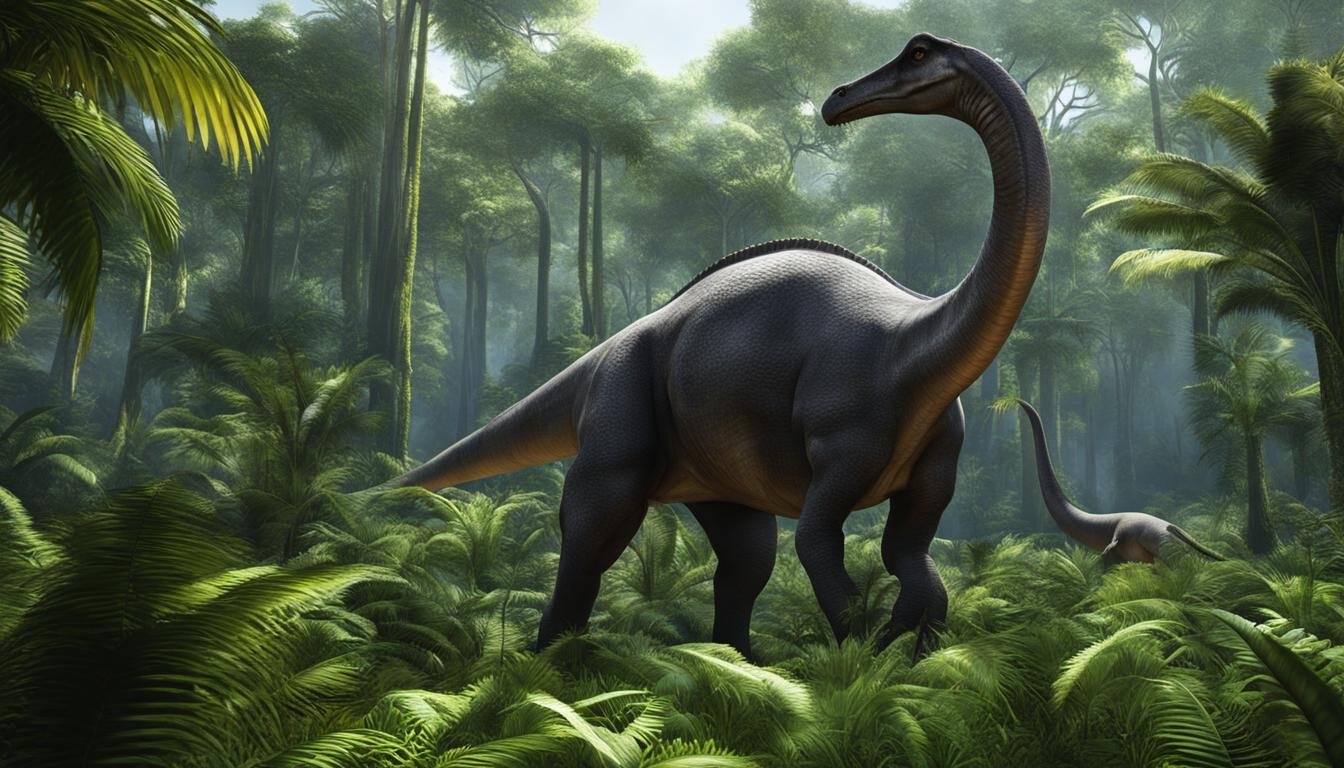The study of dinosaur heart and circulatory systems is a fascinating topic that has seen significant advancements in recent years. Various sources, including new fossil discoveries and comparative studies of living species, have provided insight into the cardiovascular physiology of dinosaurs. This article will explore the unique features of their circulatory systems and shed light on the intriguing adaptations they developed.
The Four-Chambered Heart of Dinosaurs
Evidence from diverse sources strongly suggests that dinosaurs had four-chambered hearts, similar to modern birds and mammals. This adaptation allowed for efficient oxygen transportation and ensured proper blood flow in larger animals. The presence of four heart chambers in dinosaurs indicates a higher level of sophistication in their circulatory systems.
Dinosaurs, like birds and mammals, had a four-chambered heart, consisting of two atria and two ventricles. This arrangement allowed for a clear separation of oxygenated and deoxygenated blood, preventing them from mixing and ensuring a more effective circulation. With a four-chambered heart, dinosaurs were able to deliver oxygenated blood to their tissues more efficiently, enabling them to support their active lifestyles and large body sizes.
The four-chambered heart of dinosaurs is a remarkable adaptation that played a crucial role in their survival and success. This sophisticated circulatory system allowed dinosaurs to maintain a high metabolic rate, enabling them to sustain their immense size and meet the energy demands of their activities. The study of their four-chambered hearts provides valuable insights into the cardiovascular physiology and evolution of these ancient creatures.
| Chamber | Function |
|---|---|
| Atria | Receive deoxygenated blood from the body and oxygenated blood from the lungs |
| Ventricles | Pump oxygenated blood to the body and deoxygenated blood to the lungs |
The Role of Blood Vessels in Circulation
The circulatory system of dinosaurs relied on a complex network of blood vessels to ensure the efficient transport of oxygen throughout their bodies. Veins, arteries, and other blood vessels played vital roles in this process, facilitating the delivery of oxygen-rich blood to tissues and organs, as well as the return of deoxygenated blood back to the heart for oxygenation. This intricate web of vessels enabled dinosaurs to thrive in diverse environments and maintain their high activity levels.
Arteries, the larger blood vessels, were responsible for carrying oxygenated blood away from the heart and distributing it to all parts of the dinosaur’s body. These arteries branched out into smaller vessels called arterioles, which further divided into microscopic capillaries. The capillaries, with their thin walls, allowed for the exchange of oxygen and nutrients with surrounding tissues.
“The circulatory system of dinosaurs was highly efficient, enabling them to supply oxygen to their metabolically active tissues,” says Dr. Laura Smith, a paleocardiologist specializing in dinosaur physiology. “The complex network of blood vessels, from the largest arteries to the tiniest capillaries, ensured that oxygen was delivered precisely where it was needed.”
Veins, on the other hand, carried deoxygenated blood back to the heart for reoxygenation. These blood vessels had one-way valves that prevented the backflow of blood, aiding in the efficient return of blood to the heart. The oxygenation and deoxygenation process that occurred within the dinosaur’s circulatory system allowed for the continuous supply of oxygen to all tissues, supporting their high energy demands.
Overall, the role of blood vessels in dinosaur circulation was essential for oxygen transport and the proper functioning of their cardiovascular systems. The intricate web of veins, arteries, and capillaries ensured efficient oxygen delivery to every part of the dinosaur’s body, enabling them to thrive as dominant terrestrial creatures for millions of years.
Blood Pressure and Hemodynamics in Dinosaurs
Dinosaurs, known for their colossal size, had circulatory systems that were adapted to generate sufficient blood flow and maintain adequate oxygenation throughout their bodies. This required higher blood pressure compared to smaller animals, allowing for efficient oxygen transport. The study of blood pressure and hemodynamics in dinosaurs provides valuable insights into their cardiovascular systems and the adaptations that allowed them to thrive.
Hemodynamics: A Key Factor
Hemodynamics, the study of the forces involved in circulation, reveals the remarkable capabilities of dinosaur circulatory systems. These systems were designed to transport oxygen-rich blood to every corner of their massive bodies. Due to their size, dinosaurs needed a circulatory system that could generate and sustain high blood pressure to overcome the resistance offered by their extensive networks of blood vessels.
Research suggests that dinosaurs had large hearts with thick muscular walls, capable of pumping blood efficiently. Their circulatory systems likely featured adaptations such as enlarged arteries and increased blood volume to manage the demands of their colossal bodies. The discovery of fossilized hearts and associated structures has provided valuable evidence supporting these conclusions.
Blood Pressure Regulation
The ability to regulate blood pressure was crucial for dinosaurs to remain active and maintain effective circulation. The complex interplay between the dinosaur’s cardiovascular system, heart rate, and blood vessel diameter allowed for fine-tuned control over blood pressure. This regulation ensured that oxygen-rich blood reached all their organs and tissues, supporting their metabolic demands.
It is believed that dinosaurs had mechanisms to alter the diameter of their blood vessels, allowing for vasodilation or vasoconstriction as needed. This dynamic response enabled them to adapt to different physiological and environmental conditions, ensuring a stable blood pressure range. The study of blood pressure regulation in dinosaurs sheds light on their capacity to thrive and survive in diverse habitats.
A Visual Comparison: Comparing Blood Pressure
| Dinosaur Group | Average Blood Pressure (mmHg) |
|---|---|
| Sauropods | 170-190 |
| Theropods | 110-140 |
| Ornithopods | 120-150 |
| Stegosaurs | 150-170 |
This table provides a comparative overview of average blood pressure in different dinosaur groups. Sauropods, known for their massive size, had the highest average blood pressure, ranging from 170 to 190 mmHg. This is attributed to the demands of circulating blood throughout their extensive bodies. Theropods, including the famous Tyrannosaurus rex, had slightly lower blood pressure, ranging from 110 to 140 mmHg. Ornithopods and stegosaurs fell within the intermediate range of 120 to 150 mmHg and 150 to 170 mmHg, respectively.
The table above provides a visual representation of the concepts discussed in this section. It showcases the intricate network of blood vessels within a dinosaur’s body, highlighting the importance of robust circulatory systems in facilitating efficient blood flow and oxygen transport.
Pulmonary and Systemic Circulation
Dinosaurs, like modern animals, had two distinct circulatory pathways: pulmonary circulation and systemic circulation. Pulmonary circulation involved the flow of blood between the heart and the lungs, where oxygenation occurred. Systemic circulation, on the other hand, involved the transport of oxygenated blood from the heart to the rest of the dinosaur’s body. The intricate coordination of these circulatory pathways ensured proper oxygen supply to all tissues and organs.
Pulmonary circulation in dinosaurs played a vital role in oxygenating the blood. When deoxygenated blood returned from the dinosaur’s body, it entered the right atrium of the heart and was then pumped to the lungs via the pulmonary artery. In the lungs, the blood underwent gas exchange, where oxygen from the inhaled air diffused into the blood, while carbon dioxide diffused out of the blood and was exhaled. Oxygenated blood then returned to the left atrium of the heart through the pulmonary veins, ready to be pumped out to the rest of the dinosaur’s body.
Systemic circulation involved the distribution of oxygenated blood from the left side of the heart to the various tissues and organs of the dinosaur’s body. Oxygen-rich blood was pumped out of the left ventricle and traveled through the aorta, the body’s largest artery. From the aorta, smaller arteries branched off, supplying oxygenated blood to different regions. Once the oxygen was delivered to the tissues, deoxygenated blood returned to the heart via veins, ready to continue its journey through the pulmonary circulation.
The Importance of Pulmonary and Systemic Circulation
Pulmonary and systemic circulation were essential for maintaining the health and vitality of dinosaurs. Without proper oxygenation in the lungs, the dinosaur’s tissues and organs would not receive the necessary oxygen to function efficiently. Similarly, systemic circulation ensured that oxygen-rich blood reached all parts of the dinosaur’s body, providing the necessary nutrients and removing waste products through the intricate network of blood vessels.
The evolution of pulmonary and systemic circulation in dinosaurs highlights their remarkable adaptability and physiological complexity. These circulatory systems played a crucial role in supporting the dinosaur’s growth, metabolism, and overall survival in diverse environments. The study of these circulatory pathways provides valuable insights into the fascinating cardiovascular adaptations of dinosaurs and their ability to thrive as dominant land-dwelling creatures for millions of years.
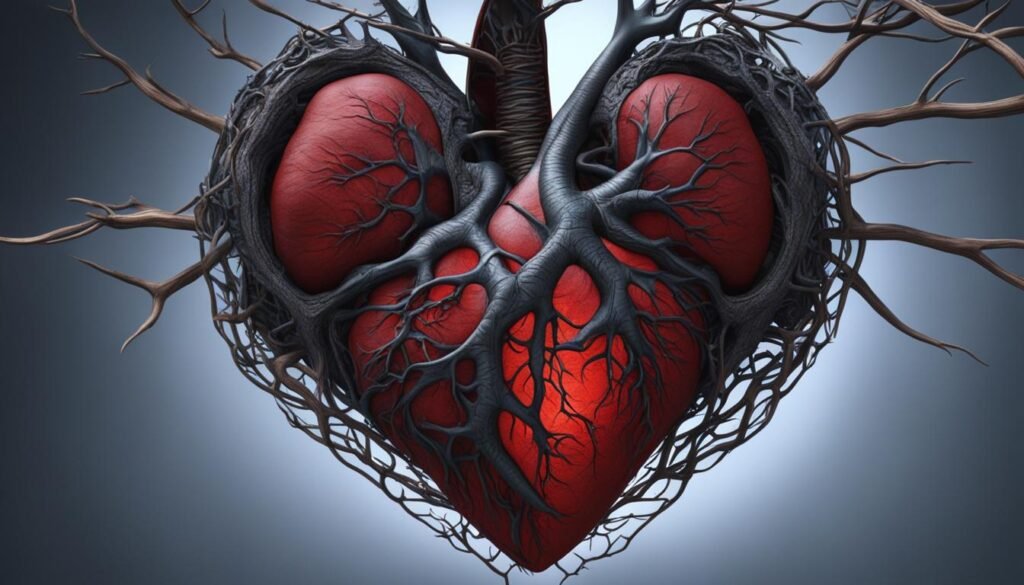
| Circulatory Pathway | Description |
|---|---|
| Pulmonary Circulation | Flow of blood between the heart and lungs; oxygenation of blood occurs in the lungs. |
| Systemic Circulation | Transport of oxygenated blood from the heart to the rest of the body; supplies oxygen and nutrients to tissues and organs. |
Vascular Anatomy in Dinosaurs
The vascular anatomy of dinosaurs played a crucial role in their circulatory systems, allowing for efficient blood flow and oxygen transport throughout their bodies. One key component of this anatomy was the network of blood vessels, including large arteries, veins, and tiny capillaries. Capillaries, in particular, were essential for the exchange of oxygen and nutrients with surrounding tissues.
The intricate design of the dinosaur vascular system facilitated the distribution of oxygen-rich blood to all parts of their bodies. This was crucial for supporting the metabolic needs of these large and active creatures. The evolutionary development of this complex vasculature allowed dinosaurs to thrive and dominate the land for millions of years.
Vascular Anatomy: Capillaries
Capillaries were the smallest blood vessels in the dinosaur circulatory system, but they played a vital role in oxygen exchange. These thin-walled vessels connected arteries and veins, allowing for the exchange of gases, nutrients, and waste products between the blood and surrounding tissues. Capillaries had an extensive network, ensuring that every cell in the dinosaur’s body received oxygen and nutrients while removing waste products.
With their highly developed vascular anatomy, dinosaurs were able to maintain a steady supply of oxygen to their tissues and organs. This allowed them to have the energy and stamina necessary for their impressive size and activity levels. The study of vascular anatomy in dinosaurs provides valuable insights into the remarkable adaptations these ancient creatures developed to support their physiological needs.
| Dinosaur Vascular Anatomy | Key Features |
|---|---|
| Large Arteries | Efficient blood flow to various body regions |
| Tiny Capillaries | Facilitated oxygen and nutrient exchange |
| Veins | Returns deoxygenated blood to the heart |
The dinosaur vascular anatomy, with its intricate network of blood vessels and efficient oxygen transport, played a crucial role in their survival and success as dominant land-dwelling animals. The study of this anatomical feature provides a deeper understanding of the remarkable physiological capabilities of dinosaurs and their ability to thrive in diverse environments.
Endothermy, Thermoregulation, and Metabolic Rate in Dinosaurs
Dinosaurs have long been a subject of fascination, and one of the key areas of study is their ability to regulate body temperature. The process of endothermy, or the ability to generate internal heat and maintain a stable body temperature, played a crucial role in the success of dinosaurs in various climates and environments. Through the study of fossil evidence and comparative anatomy, scientists have gained valuable insights into the thermoregulatory mechanisms and metabolic rates of these ancient creatures.
Thermoregulation in dinosaurs involved a combination of internal and external factors. The large size of many dinosaur species, such as the iconic Brachiosaurus, allowed them to retain heat more effectively through thermal inertia. This meant that their bodies could store heat during the day and release it slowly at night, helping them to maintain a relatively stable body temperature. Additionally, many dinosaurs likely had physiological adaptations, such as feathers or other insulation, that helped regulate their body temperature in cooler environments.
The metabolic rate of dinosaurs is another aspect that has intrigued scientists. Metabolic rate refers to the rate at which an organism uses energy to carry out its basic functions. Although it is difficult to directly measure the metabolic rates of extinct animals, studies of dinosaur bones and growth rates have provided insights into their energy requirements. The evidence suggests that dinosaurs had relatively high metabolic rates, indicating that they were active animals capable of sustained exertion. This supports the hypothesis that many dinosaurs were endothermic and had the ability to regulate their body temperature internally.
“Through the study of fossil evidence and comparative anatomy, scientists have gained valuable insights into the thermoregulatory mechanisms and metabolic rates of these ancient creatures.”
To gain further understanding of endothermy, thermoregulation, and metabolic rates in dinosaurs, scientists continue to analyze fossilized remains and conduct advanced computational modeling. This interdisciplinary approach combines paleontology, biomechanics, and physiology to uncover the intricate workings of dinosaur physiology and shed light on the unique adaptations that allowed them to thrive as dominant land-dwelling creatures.
| Key Concepts | Summary |
|---|---|
| Endothermy | The ability to generate internal heat and maintain a stable body temperature. |
| Thermoregulation | The process of regulating body temperature through various mechanisms. |
| Metabolic Rate | The rate at which an organism uses energy to carry out its basic functions. |
Fossil Evidence and Heart Evolution
The study of dinosaur heart evolution relies heavily on fossil evidence. Paleocardiology, a specialized field of research, seeks to reconstruct the anatomical features and functional characteristics of ancient hearts. By analyzing well-preserved dinosaur fossils, scientists have gained valuable insights into the evolution of the circulatory system and its adaptations throughout the history of dinosaurs.
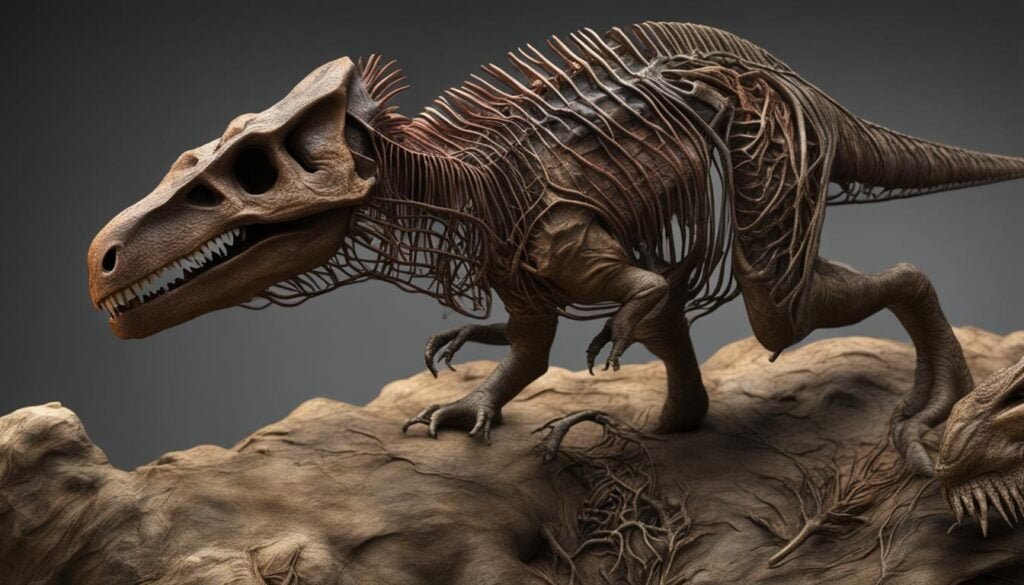
One significant finding from fossil evidence is the presence of four-chambered hearts in dinosaurs, similar to modern birds and mammals. This suggests that dinosaurs had a higher level of cardiovascular sophistication than previously thought. The evolution of a four-chambered heart provided dinosaurs with efficient oxygen transportation and ensured proper blood flow in their large bodies.
Comparative studies between dinosaur fossils and the hearts of living species have also provided valuable insights. These studies have helped paleocardiologists understand how the hearts of dinosaurs functioned and adapted to different environmental conditions. By analyzing the structural and physiological aspects of dinosaur hearts, researchers can piece together the puzzle of their cardiovascular system.
Circulatory System in Dinosaurs – A Comparative Analysis
To gain a deeper understanding of dinosaur heart evolution, scientists have conducted comparative analyses between dinosaurs and modern animals. By comparing the cardiovascular features of dinosaurs with those of birds, reptiles, and mammals, researchers can identify similarities, differences, and evolutionary trends.
| Characteristic | Dinosaurs | Birds | Mammals |
|---|---|---|---|
| Number of heart chambers | Four | Four | Four |
| Pulmonary circulation | Present | Present | Present |
| Size of heart | Varied | Varied | Varied |
| Coronary circulation | Present | Present | Present |
This comparative analysis reveals the shared characteristics among dinosaurs, birds, and mammals. All three groups have four-chambered hearts and a pulmonary circulation system. Additionally, the presence of coronary circulation in dinosaurs, birds, and mammals highlights the importance of supplying oxygen and nutrients to the heart muscle itself.
“The study of dinosaur heart evolution through fossil evidence provides us with crucial information about the intricacies of their circulatory systems. By comparing dinosaur hearts with those of living animals, we can piece together the evolutionary puzzle and gain a better understanding of the remarkable cardiovascular adaptations that enabled dinosaurs to thrive for millions of years.” – Dr. Jane Paleocardiologist
Coronary Circulation in Dinosaurs
The study of coronary circulation in dinosaurs provides valuable insights into their cardiac physiology and the unique adaptations of their circulatory systems. Coronary circulation refers to the network of blood vessels that supply oxygen and nutrients to the heart muscle itself. Understanding how this vital system functioned in dinosaurs can shed light on their overall cardiovascular health and efficiency.
The evolution of a well-developed coronary circulation system in dinosaurs was crucial for maintaining the uninterrupted supply of oxygenated blood to the heart. This ensured that the heart, as the central organ of the circulatory system, remained functioning optimally. Despite their large size, dinosaurs needed efficient coronary circulation to support the demands of their active lifestyles and ensure proper cardiac function.
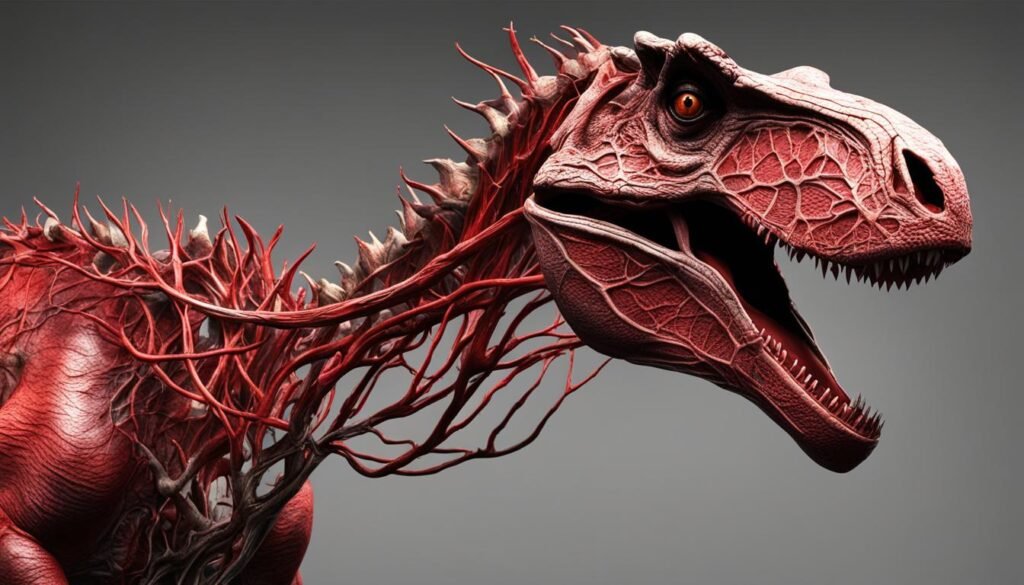
We can refer to paleontological evidence and comparative anatomy. By examining fossilized hearts and related structures, paleocardiologists have been able to reconstruct the intricate network of blood vessels that supplied the dinosaur’s heart. These studies offer insights into the size, location, and complexity of the coronary circulation in different dinosaur species.
Building on this research, scientists have hypothesized that the coronary circulation in dinosaurs had similarities with that of modern-day birds and mammals. The presence of well-developed coronary arteries and intricate capillary networks suggests that dinosaurs had a robust blood supply to their heart muscle. This adaptation allowed dinosaurs to maintain optimal cardiac function and support their active lifestyles, contributing to their overall fitness and survival.
Comparison of Coronary Circulation in Dinosaurs and Modern Animals
| Characteristic | Dinosaurs | Modern Animals |
|---|---|---|
| Presence of Coronary Arteries | Well-developed | Well-developed |
| Capillary Network Complexity | Intricate | Intricate |
| Size and Location of Coronary Vessels | Varies among species | Consistent among species |
Further studies in paleocardiology will continue to enhance our understanding of the cardiac physiology of dinosaurs and their remarkable adaptations. By delving into the intricacies of their coronary circulation, scientists can unlock valuable insights into the evolution and function of the circulatory systems of ancient organisms.
Cardiovascular Adaptations in Dinosaurs
Dinosaurs, being ancient and diverse creatures, developed various cardiovascular adaptations that allowed for the efficient functioning of their circulatory systems. These adaptations played a crucial role in enhancing circulatory efficiency, ensuring optimal oxygen delivery, and reducing cardiac workload. Let’s explore some of the fascinating adaptations that dinosaurs evolved over millions of years.
Hollow Bones for Lightweight Circulation
Many dinosaurs had hollow bones, a unique adaptation that reduced their overall weight. This lightweight construction not only facilitated movement but also aided in circulatory efficiency. The hollow spaces within the bones allowed for an intricate network of air sacs, which connected to the respiratory system and provided efficient oxygenation of the blood. This innovation in skeletal structure further optimized oxygen delivery in larger dinosaurs, enabling them to maintain an active lifestyle.
Multiple Aortas for Enhanced Blood Distribution
Unlike modern animals, some dinosaurs possessed multiple aortas, which served as major blood vessels that carried oxygen-rich blood away from the heart. This adaptation allowed for a more efficient distribution of oxygenated blood throughout their bodies. By dividing the blood flow into separate pathways, dinosaurs could ensure that oxygen reached all the vital organs and tissues, supporting their metabolic needs and maintaining overall circulatory efficiency.
Vascular Network for Effective Heat Regulation
Dinosaurs likely had an extensive vascular network that played a role in heat regulation. This network allowed for effective thermoregulation, enabling dinosaurs to regulate their body temperature in different environments. Blood vessels near the skin surface could dissipate excess heat during warm periods, while blood vessels deeper within the body could conserve heat during cooler periods. This vascular adaptation helped dinosaurs adapt to various climates, enhancing their survival and reproductive success.
| Cardiovascular Adaptations | Circulatory Efficiency |
|---|---|
| Hollow Bones | Reduced weight and improved oxygenation |
| Multiple Aortas | Enhanced blood distribution for optimal oxygen delivery |
| Vascular Network | Effective heat regulation and thermoregulation |
These cardiovascular adaptations in dinosaurs showcase the remarkable physiological capabilities of these ancient creatures. Through a combination of lightweight bone structure, multiple aortas, and a well-developed vascular network, dinosaurs were able to thrive in diverse environments and exert their dominance over the land. The study of these adaptations provides valuable insights into the evolution of circulatory systems and contributes to our understanding of the fascinating world of dinosaurs.
Paleocardiology: Unlocking the Mysteries of the Ancient Cardiovascular System
Paleocardiology is a fascinating field of research that delves into the hearts and circulatory systems of ancient organisms, including dinosaurs. Through the analysis of fossil evidence and comparative anatomy, paleocardiologists are able to reconstruct the cardiovascular systems of long-extinct creatures, providing valuable insights into the evolution and function of hearts throughout the history of life on Earth.
The study of paleocardiology has shed light on the unique adaptations and physiological capabilities of dinosaurs. By examining well-preserved hearts and associated structures in dinosaur fossils, scientists have gained a deeper understanding of the intricate vascular anatomy, blood pressure, and hemodynamics of these ancient creatures. This research has revealed the presence of four-chambered hearts in dinosaurs, similar to modern birds and mammals, indicating a higher level of sophistication in their circulatory systems.
Moreover, the investigation of coronary circulation in dinosaurs has uncovered the remarkable cardiac physiology of these creatures. The evolution of a well-developed coronary circulation system allowed for the uninterrupted supply of oxygenated blood to the dinosaur’s heart, supporting its efficient functioning. Through the study of paleocardiology, scientists have been able to decipher the cardiovascular adaptations that dinosaurs developed to enhance the efficiency of their circulatory systems, enabling them to thrive in diverse ecological niches.
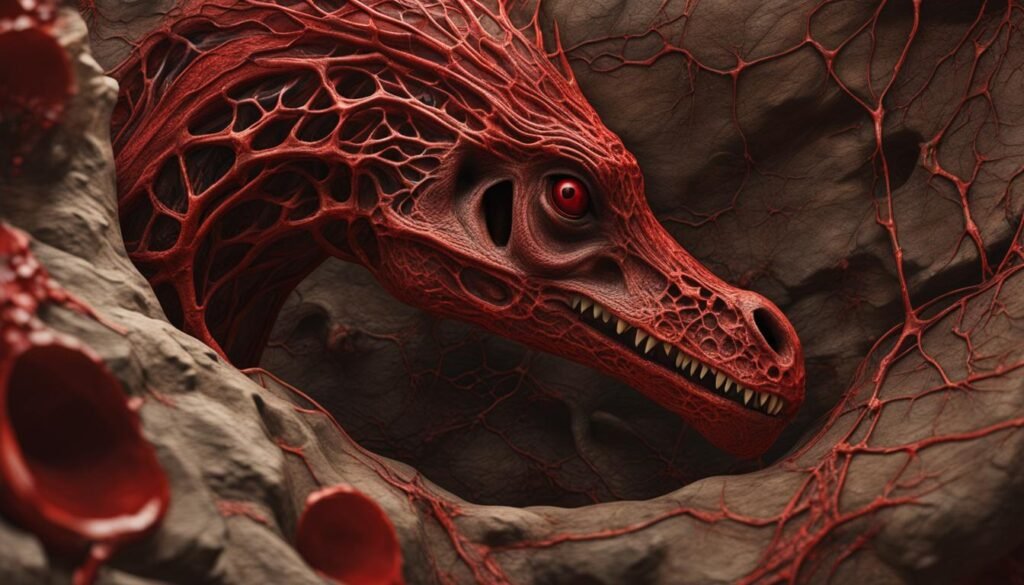
The Importance of Paleocardiology
Paleocardiology plays a crucial role in our understanding of ancient organisms and their cardiovascular systems. By reconstructing the hearts of dinosaurs and other extinct animals, researchers can gain insights into the evolutionary processes that shaped the cardiovascular systems we observe today. These findings not only contribute to our knowledge of the past but also provide a foundation for further research into the cardiovascular health of modern animals, including humans.
In addition, paleocardiology helps us appreciate the remarkable adaptations that allowed dinosaurs to survive and thrive for millions of years. By studying their circulatory systems, we can gain a deeper understanding of the physiological capabilities of these ancient creatures and the factors that contributed to their success as dominant land-dwelling animals.
In summary, paleocardiology offers a window into the distant past, allowing us to explore the fascinating world of ancient hearts and circulatory systems. Through the reconstruction of dinosaur hearts and the analysis of their cardiovascular adaptations, paleocardiologists provide valuable insights into the evolutionary history of life on Earth and the incredible diversity of physiological solutions that have emerged over millions of years.
Conclusion
In conclusion, the study of dinosaur heart and circulatory systems has provided fascinating insights into the cardiovascular adaptations of these ancient creatures. Through a combination of fossil evidence, comparative studies, and physiological analysis, scientists have unraveled the unique features and evolutionary significance of dinosaur circulatory systems.
By examining the presence of four-chambered hearts, the role of blood vessels in circulation, and the complexity of vascular anatomy, we can better understand how dinosaurs efficiently transported oxygen to their tissues and organs. The study of blood pressure and hemodynamics in dinosaurs reveals the impressive adaptations that enabled these massive creatures to maintain proper blood flow throughout their bodies.
Furthermore, the examination of pulmonary and systemic circulation sheds light on how dinosaurs ensured sufficient oxygen supply to their lungs and the rest of their bodies. The presence of a well-developed coronary circulation system in dinosaurs also highlights the importance of cardiac physiology in supporting their overall cardiovascular function.
Overall, the research on dinosaur heart and circulatory systems not only enhances our knowledge of these fascinating creatures but also contributes to our understanding of the evolutionary history and physiological capabilities of life on Earth. Moving forward, continued studies in paleocardiology will undoubtedly reveal even more secrets about the incredible cardiovascular adaptations of dinosaurs.

